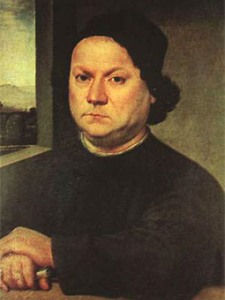(Florence 1435-Venice 1488)
Andrea Di Cone, known as Andrea del Verrocchio, was an Italian goldsmith, sculptor, and painter. He took his name from the goldsmith Giuliano Verrochi, with whom he began his artistic training. In sculpture, he trained under the guidance of Donatello. From 1465, he directed one of the most important sculptural workshops in Florence, which rivaled that of the Pollaiolo.
He was a protégé of Lorenzo de' Medici, for whom he created numerous works; in 1472, he was commissioned to erect the mausoleum of Giovanni and Pietro de' Medici in the church of San Lorenzo, where he used only ornamental motifs. From 1478 to 1483, he created one of his most original works, the group of Christ and Saint Thomas in Orsammichele, rich in contrasts of masses, in opposing formal tensions, and in chiaroscuro of garments.
With a different style and spirit, he confronted some of the most famous themes of Donatello: his David (1476, Bargello) is more dreamlike than that of his master; his equestrian statue B. Colleoni (1479-1488), his last work, commissioned by Venice, is more dynamic than the Gattamelata of Padua.
In painting, Verrocchio intensified technical investigations, tending towards smooth modeling effects and a naturalistic study of lighting. In his Baptism of Christ (Uffizi), the subtlety of the two angel figures, attributed to Leonardo da Vinci, contrasts with the relative dryness of the main characters.
The Madonna with Saint Donato and Saint John the Baptist, a composition notable for its breadth and delicate landscape, was painted in collaboration with L. di Credi, who, along with Leonardo, was one of his best disciples.
Andrea Di Cone, known as Andrea del Verrocchio, was an Italian goldsmith, sculptor, and painter. He took his name from the goldsmith Giuliano Verrochi, with whom he began his artistic training. In sculpture, he trained under the guidance of Donatello. From 1465, he directed one of the most important sculptural workshops in Florence, which rivaled that of the Pollaiolo.
He was a protégé of Lorenzo de' Medici, for whom he created numerous works; in 1472, he was commissioned to erect the mausoleum of Giovanni and Pietro de' Medici in the church of San Lorenzo, where he used only ornamental motifs. From 1478 to 1483, he created one of his most original works, the group of Christ and Saint Thomas in Orsammichele, rich in contrasts of masses, in opposing formal tensions, and in chiaroscuro of garments.
With a different style and spirit, he confronted some of the most famous themes of Donatello: his David (1476, Bargello) is more dreamlike than that of his master; his equestrian statue B. Colleoni (1479-1488), his last work, commissioned by Venice, is more dynamic than the Gattamelata of Padua.
In painting, Verrocchio intensified technical investigations, tending towards smooth modeling effects and a naturalistic study of lighting. In his Baptism of Christ (Uffizi), the subtlety of the two angel figures, attributed to Leonardo da Vinci, contrasts with the relative dryness of the main characters.
The Madonna with Saint Donato and Saint John the Baptist, a composition notable for its breadth and delicate landscape, was painted in collaboration with L. di Credi, who, along with Leonardo, was one of his best disciples.


